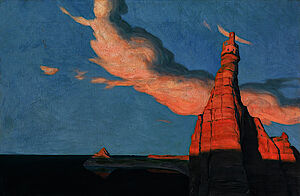Studies and other categories of works
In his "Directory of Canvases", Emmenegger made a strict distinction between six categories of work. In relation to each individual work, but also in relation to his working method as a whole, these categories are extremely revealing: "Studie" always means that he created the work in the open air. "Esquisse" is the term he used to describe the realisation of an idea without direct reference to nature (see fig.). "Studie-esquisse" stands for a study that he combined with an idea. "Bild" always refers to a work created in the studio based on a study, esquisse or studie-esquisse. Emmenegger's last two categories, "Pochade" and "Panneau decoratif", occur less frequently in the list of canvases; they stand for small-format landscape sketches and large-format festive decorations.
In the period examined, Emmenegger's work is based entirely on his studies. Often created outdoors with great effort, the study is the link between the immediate impression of nature and its synthesis in the picture. When Emmenegger returned home after a painting trip with new studies, he always subjected them to a pictorial critique, which he recorded in writing, usually under the heading "Studiennotizen". The "study notes" get to the heart of his synthesis work, for in them he essentially listed the changes he planned to make when painting the actual picture and, as can be seen from the painting technique notebook, often carried them out as he had planned.
Sometimes the painter could not resist the temptation to make certain subsequent changes to the study itself, and then regretted having lost the freshness of the natural impression through such interventions. He therefore decided to allow himself to make such changes only immediately after returning home from his painting trips, as long as the memory of the natural impression was still fresh. In the summer of 1902, after his painting trip to Lake Lugano, he wrote in his diary: "Keep study notes twice. 1. compare study with nature. 2. changes as image."
Emmenegger deliberately chose relatively large formats for his studies, although this did not make the logistically arduous outdoor work any easier. As he noted in his diary, he was keen not to take home any formal ambiguities in the study that would puzzle him when he translated them into the picture. He executed the paintings after the studies either the same size or smaller.
Unlike other artists who further elaborated their open-air studies into paintings in the workshop, with Emmenegger a study always retained its original status as a study. In the list of canvases there are corrections to the titles, but not to the categories.
